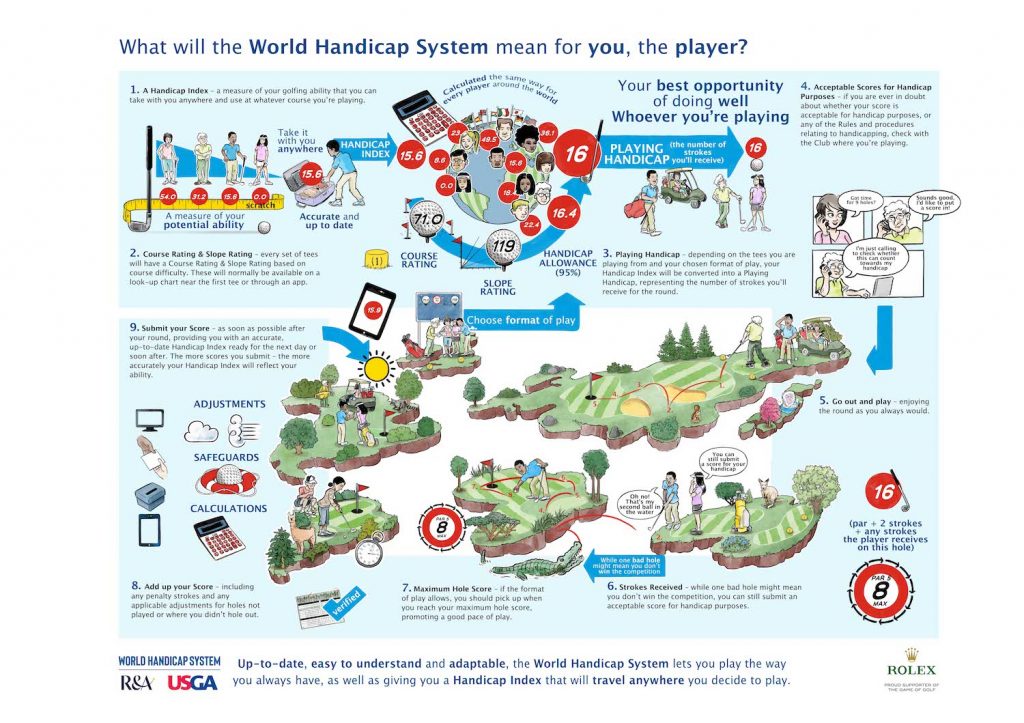
Courtesy of The R&A and USGA
THE new World Handicap System (WHS) is ready to be launched from January, the game’s governing bodies have confirmed – and will provide golfers with a “unified and more inclusive handicapping system” for the first time.
Though many countries are planning to adopt the new system in January, the system will go live in other parts of the world throughout the year with Great Britain and Ireland set to join in between September and December 2020.
The staggered introduction will accommodate different implementation plans and variations in the golfing calendar across six controlling bodies.
A new video featuring Annika Sorenstam, Gary Player as well as ordinary club golfers has been produce to help explain the changes and encourage as many people to obtain one of the new handicaps.
The video can be seen here. There are also infographics and posters, which can be used by national associations and shared by golf clubs for the benefit of golfers all over the world.
Developed by The R&A and USGA in close co-ordination with existing handicapping authorities, the World Handicap System (WHS) will provide all golfers with a consistent measure of playing ability, with handicaps calculated in the same way wherever they are in the world, they believe.
A key objective of the initiative was to develop a modern system, enabling as many golfers as possible to obtain and maintain a Handicap Index.
Golfers will be able to transport their Handicap Index globally and compete or play a casual round with players from other regions on a fair basis.
It will also indicate the score a golfer is reasonably capable of achieving the next time they go out to play.
The following table lists the estimated implementation timeframes ina number of countries.
| Time Frame* | Country |
| January | Argentina, Australia, Canada, Mexico, Panama, Republic of Korea, India, South Africa, United States, Uruguay and Venezuela |
| Feb – March – April | Hong Kong, New Zealand, Singapore and Sweden |
| May – June – July – August | Portugal |
| Sept , Oct, Nov – December | Great Britain and Ireland |
*Subject to change
The WHS has two main components – the Rules of Handicapping and the Course Rating System.
The Rules of Handicapping are encompassed within seven rules to inform administrators and golfers on how an official handicap index is calculated and administered.
Some flexibility will be given to national associations based on how the sport is played and enjoyed in their region.
The Course Rating System, based on the USGA Course Rating System first adopted nearly 50 years ago – and already adopted on nearly every continent – sets out a consistent method of determining a course’s difficulty.
Together, those components become the foundation in determining a golfer’s Handicap Index.
One of the biggest anamolies in the UK comes when elite amateurs head to the USA on golf scholarships.
Their handicaps are effectively frozen while they are in the States because their scores do not count back home.
And with the number of home-based players with plus-handicaps growing each year, some find entering some of the UK’s leading amateur events – which are based on handicap rather than world rankings – more and more difficult.
And another consequence of that is some players will pick which events – or courses – they play to protect either their World Amateur Golf Ranking, or their handicap.
R&A chief executive Martin Slumbers said, “The game of golf is transforming to meet the needs of the modern-day golfer.
“Modernising the rules this year was an important step forward in that regard and the World Handicap System will be another.
“Our hope is the launch of the WHS will be a catalyst for change – signalling the start of a new era of golfer engagement, being inclusive by embracing all golfers, whatever their level of ability, and broadening its appeal to a much wider audience.
“Change also means opportunity and, managed appropriately, this can only be good for the game.
“It does mean there will be a period of adjustment, as we saw with the new rules, but once it beds in golfers and golf clubs will benefit in many ways from the new system,” Mr Slumbers added.
“When the golf community works together, everyone benefits,” said USGA chief executive Mike Davis.
“We have seen the benefit handicapping has provided for decades, providing greater enjoyment for all who play.
“To have a single set of Rules of Handicapping for the game will connect golfers from country to country, and we are excited to bring the best of all worlds together through this initiative.
“It is one of the many ways we are investing in golf’s future, to strengthen and foster growth of the entire game for years to come.”
In preparation for the launch of the WHS, more than 3,000 golf courses have been rated for the first time.
An extensive education program has also been delivered on both sides of the Atlantic, as well as South America, Africa, Asia, and Australasia.
By the end of 2019, more than 90 national associations will have attended an educational seminar, and a robust library of resources is hosted online at WHS.com to support regional education.
Rules of Handicapping books are being produced and will be translated and delivered through national associations.
The materials produced to explain the system’s key features, include:–
- Flexibility in formats of play – allowing both competitive and recreational rounds to count for handicap purposes, ensuring a Handicap Index reflects demonstrated ability
- Minimal number of scores needed to obtain new handicap – 54 holes from any combination of 18 and nine-hole rounds (with some discretion for national or regional associations)
- Average-based calculation of a handicap – taken from best eight out of the last 20 scores, and factoring in memory of demonstrated ability for better responsiveness/control
- Calculation considering external factors – including impact of abnormal course and weather conditions on players’ performances each day
- Timely handicap revisions
- A limit of nett double bogey on maximum hole score – for handicapping purposes only
- Maximum handicap limit of 54.0 – regardless of gender which will encourage more golfers to measure and track their performance to increase their enjoyment of the game
Eight years of work to create golf’s WHS
THE formation of a World Handicap System was first conceived in 2011 between the USGA and The R&A in an effort to get more golfers involved in the game – and promote equity, no matter where golf is played.
The new WHS unites six existing handicapping systems into one, while embracing the many ways the sport is played across cultures, say the organising bodies.
Beginning in 2020, the new WHS will be governed by The R&A and the USGA and administered by national and regional golf associations around the world.
The existing six handicapping authorities represent approximately 15 million golfers in 80 countries who currently maintain a golf handicap.
They are:–
Golf Australia
Council of National Golf Unions (CONGU) Great Britain and Ireland European Golf Association (EGA)
South African Golf Association (SAGA)
Argentine Golf Association (AAG)
The United States Golf Association (USGA)




